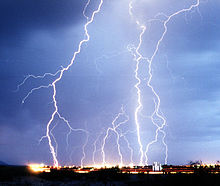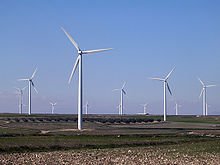Electricity
Electricity is the set of physical phenomena associated with the presence and flow of electric charge. Electricity gives a wide variety of well-known effects, such as lightning, static electricity, electromagnetic induction and electric current. In addition, electricity permits the creation and reception of electromagnetic radiation such as radio waves.

In electricity, charges produce electromagnetic fields which act on other charges. Electricity occurs due to several types of physics.
Multiple lightning strikes on a city at nightElectrical phenomena have been studied since antiquity, though progress in theoretical understanding remained slow until the seventeenth and eighteenth centuries. Even then, practical applications for electricity were few, and it would not be until the late nineteenth century that engineers were able to put it to industrial and residential use. The rapid expansion in electrical technology at this time transformed industry and society. Electricity's extraordinary versatility means it can be put to an almost limitless set of applications which include transport, heating, lighting, communications, and computation. Electrical power is now the backbone of modern industrial society.
In the 6th century BC, the Greek philosopher Thales of Miletus experimented with amber rods and these experiments were the first studies into the production of electrical energy. While this method, now known as the triboelectric effect, can lift light objects and generate sparks, it is extremely inefficient. It was not until the invention of the voltaic pile in the eighteenth century that a viable source of electricity became available. The voltaic pile, and its modern descendant, the electrical battery, store energy chemically and make it available on demand in the form of electrical energy.The battery is a versatile and very common power source which is ideally suited to many applications, but its energy storage is finite, and once discharged it must be disposed of or recharged. For large electrical demands electrical energy must be generated and transmitted continuously over conductive transmission lines.
A wind farm of about a dozen three-bladed white wind turbines.

Electrical power is usually generated by electro-mechanical generators driven by steam produced from fossil fuel combustion, or the heat released from nuclear reactions; or from other sources such as kinetic energy extracted from wind or flowing water. The modern steam turbine invented by Sir Charles Parsons in 1884 today generates about 80 percent of the electric power in the world using a variety of heat sources. Such generators bear no resemblance to Faraday's homopolar disc generator of 1831, but they still rely on his electromagnetic principle that a conductor linking a changing magnetic field induces a potential difference across its ends. The invention in the late nineteenth century of the transformer meant that electrical power could be transmitted more efficiently at a higher voltage but lower current. Efficient electrical transmission meant in turn that electricity could be generated at centralised power stations, where it benefited from economies of scale, and then be despatched relatively long distances to where it was needed.